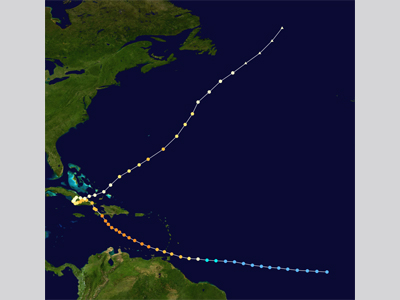Basic Statistics
Dates
Maximum wind speed Minimum pressure Deaths Damage Landfall
September 26- October 12, 1963
230 km/hr (145 mph) 940 mb 8000 528 Million U.S. Haiti, Cuba, Bahamas Hurricane Flora is among the deadliest Atlantic hurricanes in recorded history. It began as tropical depression in the Intertropical Convergence Zone on September 26, 1963, about 1215 km (755 mi) southwest of the Cape Verde island of Fogo. Initially, the depression was poorly organized as it moved west-northwest across the Atlantic. Convection finally improved enough to allow the system to develop into Tropical Storm Flora on 29 September while located about 560 km (350 mi) north of Cayenne, French Guiana. From that point, the storm quickly intensified, becoming a hurricane the next day. On 30 September, the storm made landfall on the island of Tobago as a Category 3 hurricane with winds of 193 km/h (120 mph). The hurricane damaged or destroyed 6,250 of the 7,500 houses on the island. Property and crop damage in on the island amounted to $30 million (1963 USD) with 18 lives lost. Neighboring Trinidad, however, was largely undamaged.
After crossing the island and entering the Caribbean Sea, the hurricane was able to strengthen to Category 4 status with winds of 225 km/h (140 mph). Hurricane Flora intensified further as it moved through the Caribbean. A peak intensity of 233 km/h (145 mph) wind speed and a low pressure of 940 mb (hPa) were reached on 3 October while the hurricane was located 169 km (105 mi) south of the Dominican Republic/Haiti. The hurricane made a second landfall, at near peak intensity, at Côtes-de-Fer on the south coast of Haiti. Winds gusted to 322 km/h (200 mph) and a 3.7 m (12 ft) storm surge was generated. As the hurricane slowly passed over the country, a great amount of rain fell. At least 1,444 mm (57 in) fell at Miragoâne, along the northern shore of the country’s southern peninsula. Great landslides were triggered in the mountainous areas of Haiti. Some towns were buried in the landslides while parts of other towns were destroyed in flash floods also caused by the heavy rainfall. Crops, including banana and coffee, were entirely destroyed by the inland flooding in most areas. Hurricane Flora killed at least 3,500 people in Haiti, although several thousand more were missing and are believed to be dead, thus, it is estimated that around 5,000 people were killed as a result of the hurricane. Monetary losses in Haiti amounted to between $125 million and $180 million (1963 USD). After moving off the Haitian coast, the weakened hurricane made another landfall in Cuba on 4 October about 48 km (30 mi) east of Guantánamo Bay. At the time of landfall in Cuba, the Category 3 hurricane packed winds of 201 km/h (125 mph). The presence of “atmospheric barriers”, including a high-pressure system to the north and an anticyclone to the west, caused the hurricane to meander over the island of Cuba and its coastal waters for 4 days. Vast amounts of rain fell and subsequent flooding incurred, and in eastern Cuba, 112 to 160 km/h (70 to 100 mph) winds lasted for over 100 hours. Isolated locations throughout the country saw exceptionally high amounts of rainfall, with the highest at Santiago de Cuba, where 2550 mm (100.4 in) fell during the event. Similar to the scenario elsewhere in the region, flooding caused damage to transportation infrastructure and crops in Cuba, especially in the southeast. Beach erosion was very significant along the northern coast of Cuba’s Camagüey Province where up to 1 km (3,300 ft) waseroded. Including a percentage of those missing that were expected to be dead, the death toll in Cuba was estimated to be 1,750. Total damages in that nation reached $300 million (1963 USD). Though it was located largely over land as it stalled over Cuba, Hurricane Flora remained a hurricane due to abundant moisture and a favorable upper level environment. The storm was a Category 1 hurricane with winds of 137-145 km/h (85-90 mph) as it moved away from Cuba on 8 October. Hurricane Flora moved through the Bahamas on 9 October. The storm re-strengthened, and the next day, Flora again reached major hurricane status 467 km (290 mi) south of Bermuda. The hurricane gradually weakened over the open Atlantic Ocean as it progressed northeastward. Flora was a Category 1 hurricane on 11 October, became extratropical on 12 October 435 km (270 mi) east-southeast of Cape Race, Newfoundland, Canada, and then completely dissipated the following day. During its 17-day lifespan, Hurricane Flora killed between 7,180-8,000 people. At the time, the significant casualties caused by the hurricane were the most for a tropical cyclone in the Atlantic Basin since the 1900 Galveston Hurricane. Hurricane Flora caused $528 million in total damage (1963 USD) across Cuba, Haiti and the Bahamas. In 2009 dollars, the destruction would amount to $3.77 billion. Fast Facts:
Sources:
Dunn, Gordon E. “The Hurricane Season of 1963.” Monthly Weather Review Vol. 92, No. 3. Mar. 1964. Pp 133-136. Web. “Hurricane Flora.” Wikipedia. 2010. Web. < http://en.wikipedia.org/wiki/Hurricane_Flora> Tropical Cyclones Affecting Trinidad and Tobago 1725 to 2000. Trinidad and Tobago Meteorological Service. Collaged by C.B. Daniel and R. Maharaj (1986) and updated by G. De Souza (2001). “Hurricane Flora (9/26 – 10/13).” 1963 Storm Archive. Weather Underground. 2010. Web. Encyclopedia of hurricanes, typhoons and cyclones. David Longshore, 1998. |


